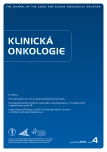Methods of Classical and Molecular Cytogenetics Suitable for Biodosimetry of Persons with Professional Exposure to Carcinogens
Authors:
Markéta Petrovová 1; Marek Svoboda 2
Authors‘ workplace:
Ambulance pracovně lékařských služeb, Masarykův onkologický ústav, Brno
1; Klinika komplexní onkologické péče, Masarykův onkologický ústav, Brno
2
Published in:
Klin Onkol 2019; 32(4): 270-276
Category:
Review
doi:
https://doi.org/10.14735/amko2019270
Overview
Background: People in the health professions and other occupations are frequently exposed to carcinogens, including chemicals, cytostatic agents, and ionizing radiation with carcinogenic potential. These individuals require monitoring of their exposure, as well as biomonitoring for cytogenetic alterations. Classical and molecular cytogenetic methods can establish functional remedial measures, while preventing the emergence of malignant tumors as an occupational disease.
Purpose: This article presents the main principles, advantages, and limitations of classical cytogenetic and modern molecular cytogenetic methods. These include conventional cytogenetic analysis of chromosomal aberrations in peripheral lymphocytes of individuals exposed to chemical carcinogens and examination of sister chromatids and micronuclei after exposure to ionizing radiation. More recent methods include radioactive and fluorescence in situ hybridization, colour variants of the latter, comparative gene hybridization, spectral karyotyping, and the latest microchip methods.
Conclusion: Molecular cytogenetic methods make possible the refinement of methods used in the biomonitoring of chemicals and radiation. Their benefits include higher speed, automation of some processes, high sensitivity, focus on stable genetic changes capable of triggering the carcinogenesis process, and the possibility of determining deviations in non-dividing cells. Their disadvantages to date include lack of analysis of large numbers of individuals undergoing preventive examinations, undetermined norms or limit values for exposed individuals and work teams, and higher costs of examination.
This work was supported from the program project of the Agency for Health Research of the Czech Republic with registration number P09-15-33968A with the fi nancial support of the Ministry of Health.
The authors declare they have no potential conflicts of interest concerning drugs, products, or services used in the study.
The Editorial Board declares that the manuscript met the ICMJE recommendation for biomedical papers.
Submitted: 15. 10. 2018
Accepted: 4. 7. 2019
Keywords:
conventional cytogenetic analysis – cytogenetic analysis – environmental monitoring – chromosome aberrations – fluorescence in situ hybridization – workplace – carcinogen
Sources
1. Cikrt M, Málek B. Pracovní lékařství I. Hygiena práce. Praha: CIVOP 1995.
2. Komárek L, Bencko V, Mika J et al. Standardní operační postupy pro biologické monitorování genotoxických účinků faktorů prostředí. AHEM: SZÚ Praha 2003.
3. Šmerhovský Z, Landa K, Rössner P et al. Risk of cancer in an occupationally exposed cohort with increased level of chromosomal aberrations. Environ Health Perspect 2001; 109 (1): 41–45. doi: 10.1289/ehp.0110941.
4. Michalová K, Zemanová Z. Klasická a molekulární cytogenetika v klinické praxi. Klin Biochem Metab 2005; 13 (34): 63–67.
5. Mitelman, F (ed). ISCN 1995. An international system for human cytogenetic nomenclature (1995). Recommendations of the international standing committee on human cytogenetic nomenclature. New York: Karger, Basel 1994.
6. Obe G, Pfeiffer P, Savage JR et al. Chromosomal aberrations: formation, identification and distribution. Mutat Res 2002; 504 (1–2): 17–36. doi: 10.1016/s0027-5107 (02) 00076-3.
7. Rössner P, Srám RJ, Bavorová H et al. Spontaneous level of chromosomal aberrations in peripheral blood lymphocytes of control individuals of the Czech Republic population. Toxicol Lett 1998; 96–97: 137–142.
8. Rössner P, Boffetta P, Ceppi M et al. Chromosomal aberrations in lymphocytes of healthy subjects and risk of cancer. Environ Health Perspect 2005; 113 (5): 517–520. doi: 10.1289/ehp.6925.
9. Bonassi S, Hagmar L, Strömberg U et al. Chromosomal aberrations in lymphocytes predict human cancer independently of exposure to carcinogens. European Study Group on Cytogenetic Biomarkers and Health. Cancer Res 2000; 60 (6): 1619–1625.
10. Očadlíková D, Bavorová H, Šmíd J. Metody biologického monitorování genotoxických účinků faktorů prostředí. Cytogenetická analýza periferních lymfocytů. AHEM: SZÚ Praha 2007. [online]. Dostupné z: http: //www.szu.cz/uploads/documents/knihovna_SVI/pdf/2007/full_2007_01.pdf.
11. Hayashi M. The micronucleus test – most widely used in vivo genotoxicity test. Genes Environ 2016; 38: 18. doi: 10.1186/s41021-016-0044-x.
12. Norppa H, Bonassi S, Hansteen IL et al. Chromosomal aberrations and SCEs as a biomarker of cancer risk. Mutat Res 2006; 600 (1–2): 37–45. doi: 10.1016/j.mrfmmm.2006.05.030.
Labels
Paediatric clinical oncology Surgery Clinical oncologyArticle was published in
Clinical Oncology

2019 Issue 4
Most read in this issue
- Current Perspective on HPV-Associated Oropharyngeal Carcinomas and the Role of p16 as a Surrogate Marker of High-Risk HPV
- Role of the Microbiome in the Formation and Development of Colorectal Cancer
- Oncology Case Report – When Is the Appropriate Time to Integrate Palliative Care?
- Incidence and Risk Factors of Distant Metastases of Head and Neck Carcinoma
